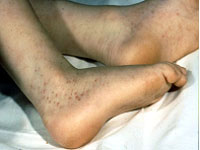What is cryoglobululmic vasculitis? What is Purpur Shenlein-Genoch? What is the granulomatosis of Vegener? What is granulomatous angiitis of church-rash? What is microscopic polyanyit? Answers you will find in this article.
Content
Cryoglobulinemic vasculitis
Esetential cryoglobululmic vasculitis is a disease in which damage to small vessels with cryoglobulinemic complexes with lesions of the skin and kidney glomers. Cryoglobulins are immunoglobulins or immunoglobulin-containing complexes, which at low temperatures spontaneously fall into precipitate, forming a gel; When the temperature is raised, they become soluble again.
The cause of the cryoglobulinemic vasculitis can be long overcooling, hepatitis B viruses and with.
Root cryoglobulinemic vasculitis predominantly women older than 50 years. The leading sign is a rash (palpable purple) on the skin of the shins and stop, accompanied by itching or burning. Skin changes can be caused by cold exposure, pressure on the skin or long standing. The appearance of the rash is accompanied by pain in the muscles and joints. In the place of the skin purple it is possible to develop necrosis and trophic ulcers (especially on the legs). Ability to defeat the kidneys according to the type of glomerulonephritis and lungs with shortness of breath and hemoprod.
The diagnosis is confirmed by the detection of cryoglobulin blood serum.
Purpur Shenlein-Genoch (hemorrhagic vasculitis)
 Hemorrhagic Vasculitis (Shenlein-Genoch's Disease) - Systemic Vascular disease with preferably defeat capillaries, arterioles and veins, mainly skin, joints, abdominal cavity and kidneys.
Hemorrhagic Vasculitis (Shenlein-Genoch's Disease) - Systemic Vascular disease with preferably defeat capillaries, arterioles and veins, mainly skin, joints, abdominal cavity and kidneys.
The disease usually occurs in children and adolescents, less often in adults of both sexes, after suffering infection (streptococcal angina or aggravation of tonsillitis, pharyngitis), the introduction of vaccines and sera, and in connection with drug intolerance, cooling.
The autoimmune nature of the disease is most likely. T.E. Vascular cells begin to briskly as an alien organism Agent and attacked by own protective cells of the body.
The disease is manifested by triad signs: hemorrhagic spindles on the skin (purple), pain in the joints (arthralgia) and (or) inflammation of the joints (arthritis), mainly large joints, and abdominal syndrome, which is noted in 70% of patients. The last two signs are usually accompanied by fever. Most often occurs a skin (simple) option characterized by skin rashes with symmetric rash on the limbs, buttocks, less often on the body. When pressing the elements of the rash do not disappear. The articulated version arises along with the skin or a few days after it and is manifested by pain in large joints. In a few days, the pain passes, but with a new wave may occur again. The abdominal syndrome is characterized by hemorrhagic rash in the mucous membrane of the gastrointestinal tract, mesentery, peritoneum, which leads in some cases to ulceration and perforations with the development of peritonitis. Clinically manifests itself with sudden pains by the type of intestinal colic, vomiting and diarrhea with blood, reminding the abdominal pathology of another nature (ulcerative disease, ulcerative colitis, dysentery). Abdominal syndrome usually passes in 2-3 days. It is often observed a combination of abdominal form with kidney damage, which is manifested by the appearance of protein and blood in the urine. The most dangerous is a lightning form. The extreme severity of the lightning form is due to the generalized nature of the rash, which often leads to a fatal outcome of hemorrhages in the brain and his shell.
Diagnostics is based on the presence of a characteristic triad of signs or only hemorrhagic skin rashes.
Granulomatosis Vegener
Vegeber granulomatosis is an inflammatory disease of the vessels with predominant damage to the arteries and veins of the middle and small caliber, as well as the vessels of the microcirculatory bed of the respiratory tract, lungs and kidneys.
Among the possible causes of granulomatosis of the GRV venener, microbial or viral factor are more likely. The disease often occurs after ARVI, hypothermia, vaccination, antibiotic therapy, but can develop healthy children.
The disease begins at any age, but more often in 40-45 years. The upper respiratory tract is affected - ulceration, necrosis appear; Lightweight - infiltrates with decay; Kidney - Glomerulonephritis. Two forms of vegetable granulomose - local and generalized.
The first complaints in the granulomatosis of Vegener are headache complaints, ears pain and mouth, nasal bleeding, hemoptysis, century swelling, runny nose. During the defeat of the ENT organs, there is a thrust rhubber with a blood-purged discontinued, the picture of the hymorite, necromizes the mucous membrane of the nasal strokes, soft sky, almonds. Then the destruction of the nasal partition, shells with a perforation of soft and solid sky. During lung radiography, double-sided rounded infiltrates with the collapse and the formation of cavities.
With the generalized form of the granulomatosis of Vegener in a few weeks or months against the background of the progressive necrotic process, skin syndrome appears in the primary focus - a variety of, noded, hemorrhagic and pectic-necrotic elements, some patients develop myocarditis, pericarditis, bronchitis.
However, the most terrible in prognostic terms is the glomerulonephritis joining in this stage. It proceeds without arterial hypertension, with a rapid development of renal failure.
Granulomatous angiitis
Allergic vasculitis or granulomatous angiitis of the soda-stroke is an inflammatory disease of small and medium vessels, mainly skin, peripheral nerves and lungs. People are sick at the age of 30-40 years.
The disease is characterized by a clinical picture of bronchial asthma and an increase in blood eosinophils in the blood. In the initial period in patients, various allergic manifestations are noted, including runny nose, pollinosis and bronchial asthma.
Syndrome singer-rafter is assumed if a person having a history of allergy or bronchial asthma symptoms is revealed to increase the amount of eosinophils in the blood in combination with a systemic disease in which infiltrates in the lungs are observed (70%) or the defeat of several organs. The diagnosis is confirmed in the hospital results of biopsy damaged tissues.
Microscopic polyangiit
Microscopic polyangiite (polyarterite) is an inflammatory disease of the vessels, in which capillaries, venules and arterioles of light, kidney and leather are affected.
Microscopic polyangiite is mainly observed in middle-aged men. The appearance of fever, resistant to antibiotic therapy, weakness, weight loss, joints. On the skin can be a rash with ulcerative changes. Development of lungs with shortness of breath, hemlooking and possible heavy pulmonary bleeding. In contrast to the granulomatosis of vegeter radiologically, infiltrates without decay are found in the lungs. It is possible to develop a hemorrhagic or fast-moving fibrosising alveolitis. The lesion of the kidney glomers is manifested by the appearance of protein and blood impurities in urine, it is possible to develop nephrotic syndrome. In the case of a fast-crossing glomerulonephritis in 3-6 months, a picture of renal failure is developing.









